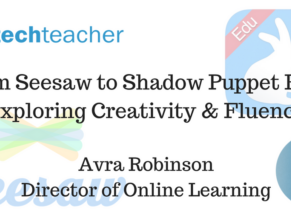Want to know more about what Avra is doing in classrooms? Follow her on Twitter: @avrarachel
One of our goals at EdTechTeacher is to explore new concepts and ideas with teachers in an effort to discover authentic ways of integrating technology into the classroom. One question we always ask is: “Does the technology create a functional improvement in the task?” In other words, we steer clear of using technology for the sake of using technology and instead focus on applications that provide clear educational value. Moreover, we focus on just a handful of versatile “evergreen apps” that can be used across various grades, subjects, and curriculum, allowing students to consume and curate information and collaborate, create, and share content.
In Spring 2017, I spent a week in Johns Creek, Georgia, with an inspiring group of elementary educators at Shakerag Elementary School. We were diving into the use of the Seesaw Learning Journal and Shadow Puppet EDU, both incredibly user-friendly tools that empower students and teachers to create and share digital content. As we explored these apps, one teacher shared how she’d used a class project to teach media literacy, pulling examples from online bookmakers not on Gamstop to show students how to evaluate digital platforms critically. Comparing and contrasting the two programs, we found they shared many features but had distinct strengths, sparking lively discussions about how to integrate real-world digital examples into lessons to boost engagement.
The teachers at Shakerag were already using Seesaw to have students share artifacts of learning. From the teachers’ perspective, Seesaw’s main functions were the sharing of artifacts and the creation of a community of learners. The teachers saw great potential in the opportunity to archive student work to show student growth and learning over time. But the teachers also came to realize that SeeSaw has many options for creation that go beyond its sharing and archiving capabilities.
For instance, even Shakerag’s youngest students were adept at taking a photo of their work from within the Seesaw app, recording audio to reflect on the photo, and labeling the photos with descriptive words or other annotations. They were also able to use the video option easily to record themselves reading or working math problems. With photo, video, and annotation skills, many new creative options are possible with students using SeeSaw.
Seesaw’s latest addition of Activities also provide new possibilities and improved workflow for teachers and students. Using the new Activities function of Seesaw, teachers can now create activities and push them out to students. Teachers can choose from a library of already-created activities such as note-taking, classification, labeling, and exit tickets, or they can create their own activity. When students complete the activity, they submit it via the Activity function, and all of the work is neatly organized within that activity. This function helps to further organize student work, making it even easier for teachers to assess and archive.
Since Seesaw continues to add options and features regularly, it almost seems as though it could be a “one-app solution.” One teacher asked me about the benefits to adding Shadow Puppet EDU to her arsenal of apps.
Multiple Pages
While Seesaw gives students the ability to share an artifact of learning by taking a picture of it, that artifact is limited to being one page or photo. Therefore, one of the first options the teachers and I explored with Shadow Puppet was the ability to take multiple pictures and combine them to create one artifact of learning. The K-2 students had just finished creating opinion-writing books, so the students and I spent some time taking pictures of their books.
As the teachers and I explored, one of the comparisons we made was the photo process between the two apps. The students readily understood that in Seesaw, they can take photos by using the camera icon within the app itself. They expected to be able to do so in Shadow Puppet. However the Shadow Puppet app doesn’t have a “take photo” function. With Shadow Puppet, students had to learn to take the pictures first using the camera app, and then import those images into their project. Exploring the connection between the camera app and Shadow Puppet EDU was a great opportunity for students to build fluency by moving between apps on their iPads.
Once the photos were taken, we imported them into Shadow Puppet. Students then read the pages of their books and recorded their voices. Some students liked to pause the recording as they turned the page. While paused, they would read the words to practice their fluency, and then they’d tap record again to continue recording. Some preferred to just turn the page and continue reading without stopping.
Similar User Interface
In another example of building app fluency, we continued to compare and contrast the two applications. Another wonderful feature of Shadow Puppet is its simplicity and its similarities to Seesaw. Students were already accustomed to “looking for the GREEN” in Seesaw. (As I teach new applications to students and teachers, I always look for - what I call - an app’s “favorite color.” Usually, it seems that the start, next, and submit types of buttons all tend to be one color - making it potentially easier for users to become fluent with the workflow.) Shadow Puppet and Seesaw both use the color GREEN, so it was fun and easy for the young students to remember “Green means GO.” As we began the process of creating a new Shadow Puppet video, we tapped the green “CREATE NEW” button. As we looked for the next button after selecting our images from the camera roll, it was green. When we were finished recording, the “SAVE” button was also green.
In the mini-lesson with the whole group, the students and I discussed how these apps were friends - having been made by the same company. It helped them to recognize the similarities and understand that the new environment would be similar to Seesaw.
Easy Integration
Lastly, when students were done creating in Shadow Puppet, sharing to Seesaw could not have been easier! They immediately saw the Seesaw icon as an option for sharing. As I asked what they thought we should do next, hands shot up all over the room! Sharing directly to Seesaw was second-nature to them.
Overall, it was an easy transition for teachers to use Shadow Puppet after being so adept at utilizing Seesaw. By comparing and contrasting the differences between the apps in whole group lessons, we were able to arm the students with the knowledge and skills they would need to be independently successful in the new application.


